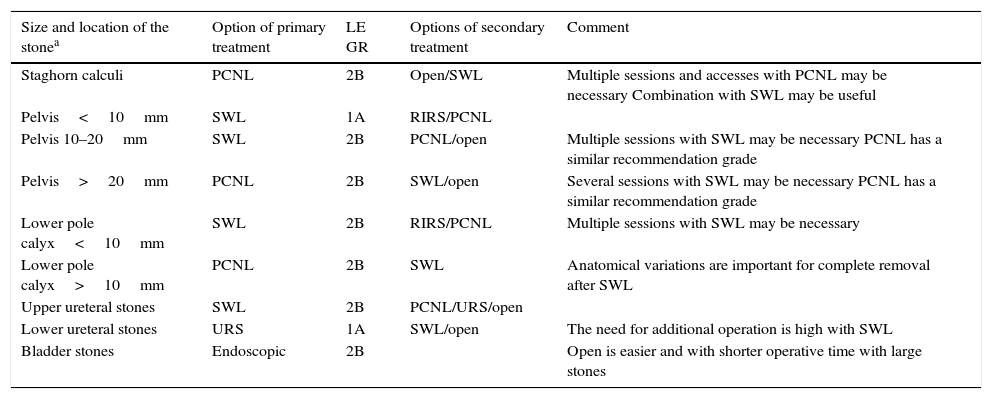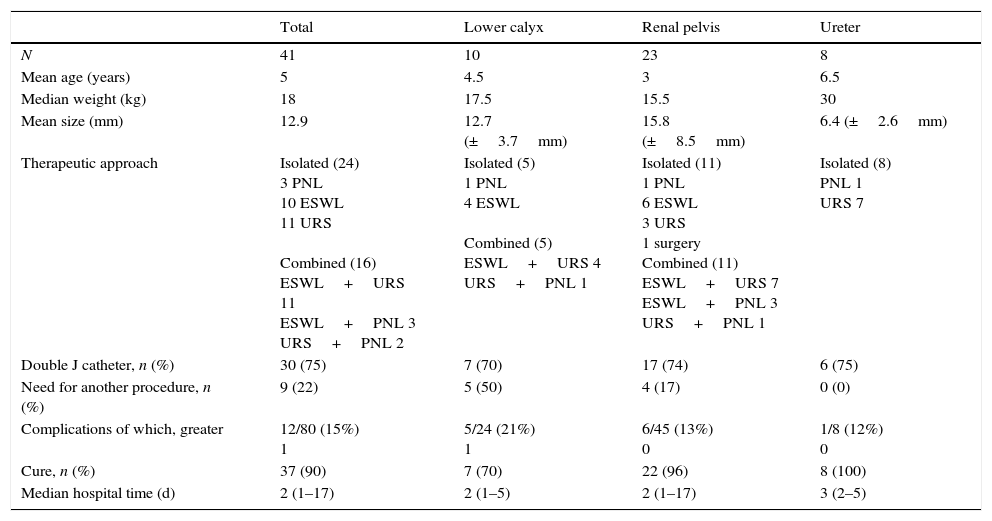We present our case studies on pediatric urolithiasis, the techniques employed in its treatment and its results.
Material and methodsA retrospective study of pediatric urolithiasis of the upper urinary tract (UUT) treated at our center between 2003 and 2014. We recorded demographic, clinical, diagnostic and therapeutic data and the complications. The therapeutic plan was recorded as isolated (extracorporeal lithotripsy, ureterorenoscopy, nephrolithotomy or surgery) or combined therapy.
ResultsWe examined 41 renoureteral units in 32 patients. The median age was 5 years (range, 11 months–14 years). The mean size was 12.9cm (±7.3mm). The locations were as follows: 23 (56%) in the renal pelvis (staghorn in 15 cases), 10 (24) in lower calyx and 8 (20%) in the ureter. We performed 80 procedures, with no differences in the age groups, which resulted in 12 complications (15%) but no septic condition secondary to lithotripsy. Stone removal from the ureter had a 100% success rate with the ureterorenoscopy. The overall cure rate was 90%.
ConclusionThe pediatric urolithiasis approach offers multiple alternatives. It is therefore important to tailor the procedure according to the size, location and composition of the stone.
In our center, the use of pediatric extracorporeal shock wave lithotripsy is safe. Ureterorenoscopy, semirigid or flexible, provides excellent results in ureters. Percutaneous nephrolithotomy with minimal access can be performed on small children and nursing infants.
Presentamos nuestra casuística de urolitiasis infantiles, técnicas empleadas en su tratamiento y sus resultados.
Material y métodosEstudio retrospectivo de urolitiasis infantiles de tracto urinario superior (TUS) tratadas en nuestro centro entre 2003-2014. Recogimos datos demográficos, clínicos, diagnósticos, terapéuticos y complicaciones. El plan terapéutico fue recogido como procedimiento aislado (litotricia extracorpórea, ureterorrenoscopia, nefrolitotomía o cirugía) o terapia combinada.
ResultadosEstudiamos 41 unidades renoureterales en 32 pacientes. La mediana de edad se situó en 5 años (rango 11 meses-14 años). El tamaño medio fue de 12,9mm (±7,3mm). La localización: 23 (56%) en pelvis renal (coraliformes en 15 casos), 10 (24%) en cáliz inferior y 8 (20%) ureterales. Realizamos 80 procedimientos, sin diferencias en los grupos de edad, encontrando 12 complicaciones (15%), sin presencia de ningún cuadro séptico secundario a litotricia. Las litiasis en localización ureteral tuvieron un 100% de tasa de éxito con la ureterorrenoscopia. El porcentaje de curación global fue del 90%.
ConclusiónEl abordaje de la urolitiasis en la infancia ofrece múltiples alternativas, por lo que es importante individualizar en función del tamaño, localización y composición del cálculo.
En nuestro centro la utilización de LEOC en niños es segura. La URS, semirrígida o flexible, obtiene excelentes resultados en el uréter. La NLP con mínimo acceso se puede realizar en niños pequeños y lactantes.











